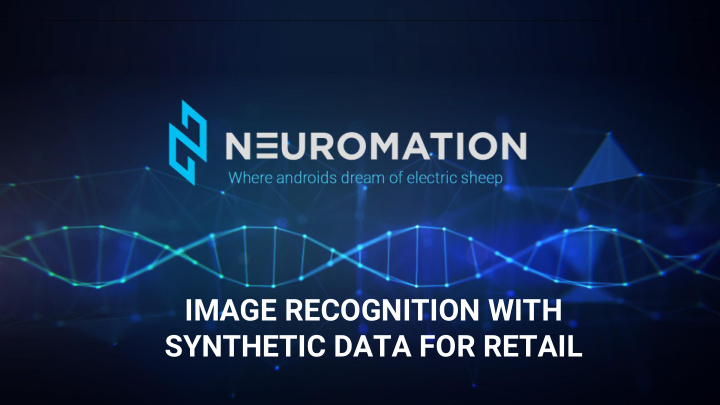



IMAGE RECOGNITION WITH SYNTHETIC DATA FOR RETAIL
THERE WILL BE В ЭТОЙ ПРЕЗЕНТАЦИИ НЕ БУДЕТ NO Наличие товара на НИ ОДНОЙ МАТЕМАТИЧЕСКОЙ MATHEMATICAL FORMULAS Chris полке ФОРМУЛЫ IN THIS PRESENTATION
Наличие товара на полке Наличие товара на полке
Solving business problems Correct results Наличие товара на полке Наличие товара на Control over the progress полке Optimizing the work of field staff Reliability of collected data
● Image recognition for objects on a supermarket shelf is the first and key stage of automation in retail ● We, humans, get 85% of our information through visual sensors (eyes) Chris ● Computer vision , i.e., training mathematical models to see and understand what they see, is a fundamental problem of automation IMAGE RECOGNITION IN RETAIL BY ECR RESEARCH: ABOUT 40 BLN IMAGES PER YEAR
We give the business 1. Cost reduction 2. Scalability Chris 3. Sales growth IN OUR SOLUTIONS, IMAGE REGOCNITION CAN BE DONE ON AN OFFLINE MOBILE DEVICE
CHALLENGES FOR IMAGE RECOGNITION Наличие товара на IN RETAIL APPLICATIONS полке
To automatically recognize goods on the ● shelf, we need to design and train deep neural networks To teach the model to distinguish ● between Pepsi Cola and Coca-Cola, it needs to “see” thousands of labeled images from both classes Chris ● Central problem in many applications of neural networks: where will the labeled data come from? LOTS OF LABELED DATA REQUIRED
● Current catalogue of goods only in Russian-speaking (ex-USSR) retail: 170 000 SKU ● Each SKU requires 1000 - 5000 labeled photos ● Moreover, the network needs “real-looking” photos, i.e., labeled products on photos from real shelves... WHERE WILL ALL THIS LABELED DATA COME FROM?
Where can you get 1 billion ● labeled photos? Today they are labeled by hand, usually ● through crowdsourcing services ● A “turker” labels ~50 photos per 8 hour workday, ~$0.2 per photo Chris PARADOX: TO AUTOMATE HUMAN LABOR, WE NEED ORDERS OF MAGNITUDE MORE HUMAN LABOR
1 BLN LABELED PHOTOS = 120 MLN WORK HOURS ● Manual labeling – years of work, hundreds of million dollars Chris ● Moreover, crowdsourcing labeling is unreliable (the human factor), and you need to cross-check, labeling each photo several times Wrong data will certainly lead to wrong models ●
THE NEUROMATION Наличие товара на SOLUTION полке
We create a virtual copy of the shelf (a 3D model) and place 3D objects ● Then we can generate unlimited amounts of labeled synthetic data ● ● We train deep neural networks on synthetic data ● Reaching good accuracy much faster and cheaper than the competition
Advantages of synthetic data We generate 100% accurate labeled ● data, with pixel-perfect labeling which is impossible to do by hand Increase the speed of automation by ● orders of magnitude ● The resulting solution is several times cheaper than hand labeling
Examples
Examples
THE SYNERGY BIG DATA + IMAGE RECOGNITION Наличие товара на FOR FMCG RETAIL BUSINESS полке
BIG DATA + IMAGE RECOGNITION OSA Hybrid Platform Image Recognition by Neuromation Chris Together we develop a new approach to solving business problems for retail through automation
SUMMA TECHNOLOGIA = SALES GROWTH Chris
IN THE NEW ECONOMY В НОВОЙ ЭКОНОМИКЕ ДАННЫЕ – DATA IS THE NEW OIL ЭТО НОВАЯ НЕФТЬ. ГЛУБОКОЕ ОБУЧЕНИЕ НА DEEP LEARNING ON Chris СИНТЕТИЧЕСКИХ ДАННЫХ ПОДОБНО SYNTHETIC DATA ПРОИЗВОДСТВУ СИНТЕТИЧЕСКОЙ IS A CHEAP AND ABUNDANT SYNTHETIC OIL НЕФТИ.
THANK YOU FOR YOUR ATTENTION! neuromation.io
Recommend
More recommend